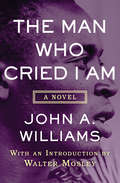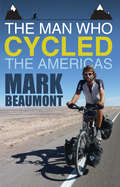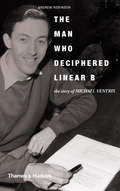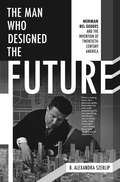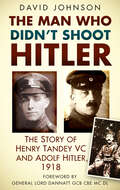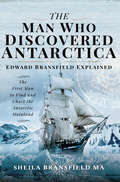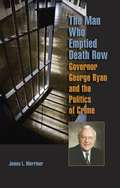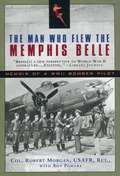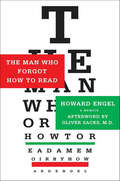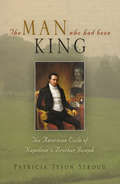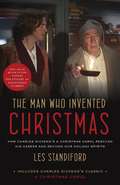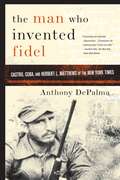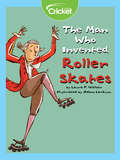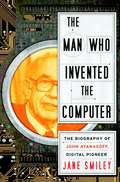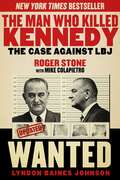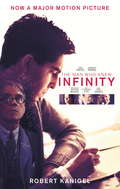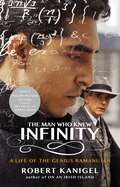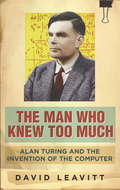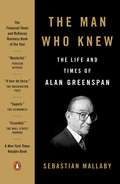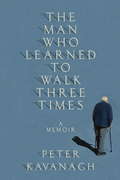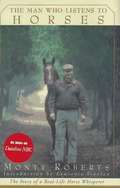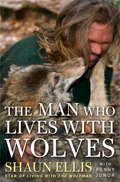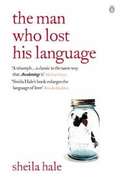- Table View
- List View
The Man Who Cried I Am: A Novel
by Walter Mosley John A. WilliamsGenerally recognized as one of the most important novels of the tumultuous 1960s, The Man Who Cried I Am vividly evokes the harsh era of segregation that presaged the expatriation of African American intellectuals. Through the eyes of journalist Max Reddick, and with penetrating fictional portraits of Richard Wright and James Baldwin, among other historical figures, John A. Williams reveals the hope, courage, and bitter disappointment of the civil rights era. Infused with powerful artistry and searing anger, as well as insight, humanity, and vision, The Man Who Cried I Am is a classic of postwar American literature.
The Man Who Cycled the Americas
by Mark BeaumontIn 2008, Mark Beaumont smashed the world record for cycling around the world, by an astonishing 81 days. His race against the clock took him through the toughest terrain and the most demanding of conditions. In 2009, Mark set out on his second ultra-endurance challenge. And this one would involve some very big mountains.The Man Who Cycled the Americas tells the story of a 15,000 mile expedition that once again broke the barriers of human achievement. To pedal the longest mountain range on the planet, solo and unsupported, presented its own unique difficulties. But no man had ever previously summited the continents' two highest peaks, Mt McKinley in Alaska and Aconcagua in Argentina, in the same climbing season, let alone cycling between them. Oh, and Mark had never even been up Ben Nevis before.Full of his trademark charm, warmth and fascination with seeing the world at the pace of a bicycle, Mark Beaumont's second book is a testament to his love of adventure, his joy of taking on tough mental and physical feats, and offers a thrilling trip through the diverse cultures of the Americas.
The Man Who Deciphered Linear B: The Story of Michael Ventris
by Andrew Robinson"Highly readable . . . a fitting tribute to the quiet outsider who taught the professionals their business and increased our knowledge of the human past."--Archaeology Odyssey More than a century ago, in 1900, one of the great archaeological finds of all time was made in Crete. Arthur Evans discovered what he believed was the palace of King Minos, with its notorious labyrinth, home of the Minotaur. As a result, Evans became obsessed with one of the epic intellectual stories of the modern era: the search for the meaning of Linear B, the mysterious script found on clay tablets in the ruined palace. Evans died without achieving his objective, and it was left to the enigmatic Michael Ventris to crack the code in 1952. This is the first book to tell not just the story of Linear B but also that of the young man who deciphered it. Based on hundreds of unpublished letters, interviews with survivors, and other primary sources, Andrew Robinson's riveting account takes the reader through the life of this intriguing and contradictory man. Stage by stage, we see how Ventris finally achieved the breakthrough that revealed Linear B as the earliest comprehensible European writing system.
The Man Who Designed the Future: Norman Bel Geddes and the Invention of Twentieth-Century America
by B. Alexandra SzerlipBefore there was Steve Jobs, there was Norman Bel Geddes. A ninth-grade dropout who found himself at the center of the worlds of industry, advertising, theater, and even gaming, Bel Geddes designed everything from the first all-weather stadium, to Manhattan's most exclusive nightclub, to Futurama, the prescient 1939 exhibit that envisioned how America would look in the not-too-distant 60s. In The Man Who Designed the Future, B. Alexandra Szerlip reveals precisely how central Bel Geddes was to the history of American innovation. He presided over a moment in which theater became immersive, function merged with form, and people became consumers. A polymath with humble Midwestern origins, Bel Geddes’ visionary career would launch him into social circles with the Algonquin roundtable members, stars of stage and screen, and titans of industry. Light on its feet but absolutely authoritative, this first major biography is a must for anyone who wants to know how America came to look the way it did.
The Man Who Didn't Shoot Hitler: The Story of Henry Tandey VC and Adolf Hitler, 1918
by David JohnsonThis is the tale of two men.The first is Henry Tandey, an ordinary man later deemed to be ‘a hero of the old berserk type’, born and brought up in Leamington Spa, Warwickshire, who displayed extraordinary courage to emerge from the First World War as the most decorated British private to survive. The second is Adolf Hitler, who was highly decorated in his service to Germany in the First World War and went on to become one of the most infamous dictators in history, later bringing the world to the brink of destruction during the Second World War. It seems unlikely that their fates should collide. Yet in 1938 Hitler named Tandey as the soldier who spared his life on 28 September 1918 in the aftermath of the Battle of Marcoing – an assertion that came as a surprise to Tandey himself. The Man Who Didn’t Shoot Hitler tells the story of Tandey’s and Hitler’s Great War, the moment when their lives became intertwined – if in fact they did – and how Tandey lived with the stigma of being known not for his chestful of medals for gallantry in service of King and Country, but as the man who let Hitler live.
The Man Who Discovered Antarctica: Edward Bransfield Explained: The First Man to Find and Chart the Antarctic Mainland
by Sheila BransfieldThe definitive biography of the British naval officer who found the Antarctic shoreline in the early nineteeth century. Captain Cook claimed the honor of being the first man to sail into the Antarctic Ocean in 1773, which he circumnavigated the following year. Cook, though, did not see any land, and declared that there was no such thing as the Southern Continent. Fifty years later, an Irishman who&’d been impressed into the Royal Navy at eighteen, and risen through the ranks to the position of master, proved Cook wrong, discovering and charting parts of the Antarctic shoreline. He also discovered Elephant Island and Clarence Island, claiming them for the British Crown. Edward Bransfield&’s naval career included taking part in the Bombardment of Algiers in 1816 onboard the 50-gun warship HMS Severn. Then, in 1817, he was posted to the Royal Navy&’s Pacific Squadron off Valparaíso in Chile, and it was while he served there that the skipper of an English whaling ship, the Williams, was driven south by adverse winds and discovered what came to be known as the South Shetland Islands where Cook had said there was no land. Bransfield&’s superior officer, Captain Sherriff, decided to investigate further. He chartered Williams and sent Bransfield with two midshipmen and a ship&’s surgeon into the Antarctic—and the Irishman sailed into history. Despite many parts of Antarctica and an Antarctic survey vessel being named after him, and a Royal Mail commemorative stamp issued in his name, the full story of this remarkable man and his historic journey, have never been told—until now. Following decades of research, Sheila Bransfield MA, a member of the UK Antarctic Heritage Trust, has produced the definitive biography of one of Britain&’s greatest maritime explorers. The book also includes a foreword by the Trust&’s patron the Princess Royal. &“Bransfield&’s meticulous research gives us a detailed account of the daily routines of the Navy and the immense amount of maintenance required of a large wooden warship in the Age of Sail.&” —Historical Novel Society
The Man Who Emptied Death Row: Governor George Ryan and the Politics of Crime
by James L. MerrinerGeorge H. Ryan, Illinois governor from 1999 to 2003, became nationally known for two significant and very different reasons. The first governor in the United States to clear out his state's death row and put a moratorium on the death penalty, he was also convicted and sent to prison on corruption charges. The Man Who Emptied Death Row: Governor George Ryan and the Politics of Crime details the career of a man who both enhanced and tarnished the image of the highest office in Illinois and examines the political history and culture that shaped him. Author James L. Merriner explores the two very different stories of George Ryan: the brave crusader against the death penalty and the petty crook. An extensive analysis of the official record, exclusive interviews, and previously undisclosed incidents in Ryan's career expose why the governor pardoned or commuted the sentences of all 171 prisoners on Illinois's death row before leaving office and how he later was convicted of eighteen counts of official corruption. This biography traces Ryan's family history and the Illinois political climate that influenced his development as a politician. Although Ryan championed "good-government" initiatives--organ donations, tougher drunken-driving and lobbyist disclosure laws--he never overcame a reputation as a wheeler-dealer, notes Merriner. Merriner goes beyond Ryan's life and career to explore the politics of crime, highlighting the successes and failures of the criminal justice system and suggesting how both white-collar fraud and violent crime shape politics. A fascinating story that reveals much about the way Illinois politics works, The Man Who Emptied Death Row will help determine how history will judge Illinois governor George Ryan.
The Man Who Flew the Memphis Belle
by Robert Morgan Ron Powers"Bring[s] a new perspective to World War II literature...Exciting" -- Library Journal. A powerful chronicle of loyalty, love, and heroism under fire, this is the unforgettable memoir of a member of the Greatest Generation who fought in America's greatest battles-and of the war one man waged both in and out of the skies. High-spirited young Robert Morgan was transformed from a fast-living, privileged playboy who grew up hobnobbing with the Vanderbilts into a steel-nerved pilot forged in the cauldron of World War II's most dangerous and desperate aerial encounters. This is the triumphant tale of that transformation-and of the plane and crew that never failed to bring him back home.
The Man Who Forgot How to Read: A Memoir
by Howard EngelThe remarkable journey of an award-winning writer struck with a rare and devastating affliction that prevented him from reading even his own writingOne hot midsummer morning, novelist Howard Engel picked up his newspaper from his front step and discovered he could no longer read it. The letters had mysteriously jumbled themselves into something that looked like Cyrillic one moment and Korean the next. While he slept, Engel had experienced a stroke and now suffered from a rare condition called alexia sine agraphia, meaning that while he could still write, he could no longer read. Over the next several weeks in hospital and in rehabilitation, Engel discovered that much more was affected than his ability to read. His memory failed him, and even the names of old friends escaped his tongue. At first geography eluded him: he would know that two streets met somewhere in the city, but he couldn't imagine where. Apples and grapefruit now looked the same. When he returned home, he had trouble remembering where things went and would routinely ?nd cans of tuna in the dishwasher and jars of pencils in the freezer. Despite his disabilities, Engel prepared to face his dilemma. He contacted renowned neurologist Dr. Oliver Sacks for advice and visited him in New York City, forging a lasting friendship. He bravely learned to read again. And in the face of tremendous obstacles, he triumphed in writing a new novel. An absorbing and uplifting story, filled with sly wit and candid insights, The Man Who Forgot How to Read will appeal to anyone fascinated by the mysteries of the mind, on and off the page.
The Man Who Had Been King
by Patricia Tyson StroudJoseph Bonaparte, King of Naples and Spain, claimed that he had never wanted the overpowering roles thrust upon him by his illustrious younger brother Napoleon. Left to his own devices, he would probably have been a lawyer in his native Corsica, a country gentleman with leisure to read the great literature he treasured and oversee the maintenance of his property. When Napoleon's downfall forced Joseph into exile, he was able to become that country gentleman at last, but in a place he could scarcely have imagined.It comes as a surprise to most people that Joseph spent seventeen years in the United States following Napoleon's defeat at Waterloo. In The Man Who Had Been King, Patricia Tyson Stroud has written a rich account--drawing on unpublished Bonaparte family letters--of this American exile, much of it passed in regal splendor high above the banks of the Delaware River in New Jersey.Upon his escape from France in 1815, Joseph arrived in the new land with a fortune in hand and shortly embarked upon building and fitting out the magnificent New Jersey estate he called Point Breeze. The palatial house was filled with paintings and sculpture by such luminaries as David, Canova, Rubens, and Titian. The surrounding park extended to 1,800 acres of luxuriously landscaped gardens, with twelve miles of carriage roads, an artificial lake, and a network of subterranean tunnels that aroused much local speculation.Stroud recounts how Joseph became friend and host to many of the nation's wealthiest and most cultivated citizens, and how his art collection played a crucial role in transmitting high European taste to America. He never ceased longing for his homeland, however. Despite his republican airs, he never stopped styling himself as "the Count de Survilliers," a noble title he fabricated on his first flight from France in 1814, when Napoleon was exiled to Elba, nor did he ever learn more than rudimentary English. Although he would repeatedly plead with his wife to join him, he was not a faithful husband, and Stroud narrates his affairs with an American and a Frenchwoman, both of whom bore him children. Yet he continued to feel the separation from his two legitimate daughters keenly and never stopped plotting to ensure the dynastic survival of the Bonapartes.In the end, the man who had been king returned to Europe, where he was eventually interred next to the tomb of his brother in Les Invalides. But the legacy of Joseph Bonaparte in America remains, and it is this that Patricia Tyson Stroud has masterfully uncovered in a book that is sure to appeal to lovers of art and gardens and European and American history.
The Man Who Heard Voices
by Michael BambergerNow in paperback, a behind-the-scenes look at the groundbreaking filmmaker M. Night Shyamalan In his relatively young career, M. Night Shyamalan has achieved phenomenal commercial and critical success. His films The Sixth Sense, Unbreakable, Signs, and The Villagehave grossed over $1. 5 billion and reinvented the thriller genre. Because Shyamalan has worked outside of the Hollywood system, however, his filmmaking habits and personality have remained largely unknown. But reporter Michael Bamberger obtained unprecedented access to Shyamalan during the tumultuous production of his film Lady in the Water, and in The Man Who Heard Voicesexposes the struggles and triumphs of this modern-day Hitchcock at work. From revising the screenplay to shooting on location and evaluating the crucial initial test screening, The Man Who Heard Voicestracks all stages in the life of Shyamalan's film. Bamberger delves into Shyamalan's relationship with the actors and the studio (he moved from Disney to Warner Bros. for this film) while also profiling various players on set. The result is a fascinating insider portrait of creative genius-and the real-life story behind a Hollywood thriller.
The Man Who Invented Christmas (Movie Tie-In): How Charles Dickens's A Christmas Carol Rescued His Career and Revived Our Holiday Spirits
by Les StandifordAs uplifting as the tale of Scrooge itself, this is the story of how Charles Dickens revived the signal holiday of the Western world. Soon to be a major motion picture. Just before Christmas in 1843, a debt-ridden and dispirited Charles Dickens wrote a small book he hoped would keep his creditors at bay. His publisher turned it down, so Dickens used what little money he had to put out A Christmas Carol himself. He worried it might be the end of his career as a novelist. The book immediately caused a sensation. And it breathed new life into a holiday that had fallen into disfavor, undermined by lingering Puritanism and the cold modernity of the Industrial Revolution. It was a harsh and dreary age, in desperate need of spiritual renewal, ready to embrace a book that ended with blessings for one and all. With warmth, wit, and an infusion of Christmas cheer, Les Standiford whisks us back to Victorian England, its most beloved storyteller, and the birth of the Christmas we know best. The Man Who Invented Christmas is a rich and satisfying read for Scrooges and sentimentalists alike.
The Man Who Invented Christmas: How Charles Dickens's A Christmas Carol Rescued His Career and Revived Our Holiday Spirits
by Les StandifordAs uplifting as the tale of Scrooge itself, this is the story of how one writer and one book revived the signal holiday of the Western world.Just before Christmas in 1843, a debt-ridden and dispirited Charles Dickens wrote a small book he hoped would keep his creditors at bay. His publisher turned it down, so Dickens used what little money he had to put out A Christmas Carol himself. He worried it might be the end of his career as a novelist.The book immediately caused a sensation. And it breathed new life into a holiday that had fallen into disfavor, undermined by lingering Puritanism and the cold modernity of the Industrial Revolution. It was a harsh and dreary age, in desperate need of spiritual renewal, ready to embrace a book that ended with blessings for one and all.With warmth, wit, and an infusion of Christmas cheer, Les Standiford whisks us back to Victorian England, its most beloved storyteller, and the birth of the Christmas we know best. The Man Who Invented Christmas is a rich and satisfying read for Scrooges and sentimentalists alike.From the Hardcover edition.
The Man Who Invented Fidel
by Anthony DepalmaIn 1957, Herbert L. Matthews of the New York Times, then considered one of the premiere foreign correspondents of his time, tracked down Fidel Castro in Cuba's Sierra Maestra mountains and returned with what was considered the scoop of the century. His heroic portrayal of Castro, who was then believed dead, had a powerful effect on American perceptions of Cuba, both in and out of the government, and profoundly influenced the fall of the Batista regime. When Castro emerged as a Soviet-backed dictator, Matthews became a scapegoat; his paper turned on him, his career foundered, and he was accused of betraying his country. In this fascinating book, New York Times reporter DePalma investigates the Matthews case to reveal how it contains the story not just of one newspaperman but of an age, not just how Castro came to power but how America determines who its enemies are. He re-creates the atmosphere of revolutionary Cuba and Cold War America, and clarifies the facts of Castro's ascension and political evolution from the many myths that have sprung up around them. Through a dramatic, ironic, in ways tragic story, The Man Who Invented Fidel offers provocative insights into Cuban politics, the Cuban-American relationship, and the many difficult balancing acts of responsible journalism.
The Man Who Invented Roller Skates
by Laura F. NielsenRegarded as a mechanical genius, John Joseph Merlin is sadly remembered most for a party at the Carlisle House, where he careened into the hostesses' plate glass mirror, wearing his newly invented roller skates, and playing the violin.
The Man Who Invented the Computer
by Jane SmileyFrom one of our most acclaimed novelists, a David-and-Goliath biography for the digital age.One night in the late 1930s, in a bar on the Illinois-Iowa border, John Vincent Atanasoff, a professor of physics at Iowa State University, after a frustrating day performing tedious mathematical calculations in his lab, hit on the idea that the binary number system and electronic switches, combined with an array of capacitors on a moving drum to serve as memory, could yield a computing machine that would make his life and the lives of other similarly burdened scientists easier. Then he went back and built the machine. It worked. The whole world changed. Why don't we know the name of John Atanasoff as well as we know those of Alan Turing and John von Neumann? Because he never patented the device, and because the developers of the far-better-known ENIAC almost certainly stole critical ideas from him. But in 1973 a court declared that the patent on that Sperry Rand device was invalid, opening the intellectual property gates to the computer revolution. Jane Smiley tells the quintessentially American story of the child of immigrants John Atanasoff with technical clarity and narrative drive, making the race to develop digital computing as gripping as a real-life techno-thriller.From the Hardcover edition.
The Man Who Killed Kennedy: The Case Against LBJ
by Mike Colapietro Roger Stone"We appreciate Roger Stone, he is one tough cookie." - President TrumpThe sensational New York Times bestseller, now in paperback.Find out how and why LBJ had JFK assassinated.The Man Who Killed Kennedy: The Case Against LBJ hit the New York Times bestseller list the week of the 50th Anniversary of the assassination of President John F. Kennedy. Consummate political insider Roger Stone makes a compelling case that Lyndon Baines Johnson had the motive, means, and opportunity to orchestrate the murder of JFK. Stone maps out the case that LBJ blackmailed his way on the ticket in 1960 and was being dumped in 1964 to face prosecution for corruption at the hands of his nemesis attorney Robert Kennedy. Stone uses fingerprint evidence and testimony to prove JFK was shot by a long-time LBJ hit man-not Lee Harvey Oswald.President Johnson would use power from his personal connections in Texas, from the criminal underworld, and from the United States government to escape an untimely end in politics and to seize even greater power. President Johnson, the thirty-sixth president of the United States, was the driving force behind a conspiracy to murder President Kennedy on November 22, 1963.In The Man Who Killed Kennedy, you will find out how and why he did it.Legendary political operative and strategist Roger Stone has gathered documents and uses his firsthand knowledge to construct the ultimate tome to prove that LBJ was not only involved in JFK’s assassination, but was in fact the mastermind.Skyhorse Publishing, as well as our Arcade imprint, are proud to publish a broad range of books for readers interested in history--books about World War II, the Third Reich, Hitler and his henchmen, the JFK assassination, conspiracies, the American Civil War, the American Revolution, gladiators, Vikings, ancient Rome, medieval times, the old West, and much more. While not every title we publish becomes a national bestseller, we are committed to books on subjects that are sometimes overlooked and to authors whose work might not otherwise find a home.
The Man Who Knew Infinity: A Life of the Genius Ramanujan
by Robert KanigelThe Man Who Knew Infinity is the true story of a friendship between Srinivasa Ramanujan and G.H. Hardy that forever changed mathematics. In 1913, a young unschooled Indian clerk wrote a letter to G H Hardy, begging the pre-eminent English mathematician's opinion on several ideas he had about numbers. Realising the letter was the work of a genius, Hardy arranged for Srinivasa Ramanujan to come to England. Thus began one of the most improbable and productive collaborations ever chronicled.With a passion for rich and evocative detail, Robert Kanigel takes us from the temples and slums of Madras to the courts and chapels of Cambridge University, where the devout Hindu Ramanujan, 'the Prince of Intuition,' tested his brilliant theories alongside the sophisticated and eccentric Hardy, 'the Apostle of Proof'. In time, Ramanujan's creative intensity took its toll: he died at the age of thirty-two and left behind a magical and inspired legacy that is still being plumbed for its secrets today.
The Man Who Knew Infinity: A Life of the Genius Ramanujan
by Robert KanigelNOW A MAJOR MOTION PICTURE STARRING JEREMY IRONS AND DEV PATEL! A moving and enlightening look at the unbelievable true story of how gifted prodigy Ramanujan stunned the scholars of Cambridge University and revolutionized mathematics.In 1913, a young unschooled Indian clerk wrote a letter to G H Hardy, begging the preeminent English mathematician's opinion on several ideas he had about numbers. Realizing the letter was the work of a genius, Hardy arranged for Srinivasa Ramanujan to come to England. Thus began one of the most improbable and productive collaborations ever chronicled. With a passion for rich and evocative detail, Robert Kanigel takes us from the temples and slums of Madras to the courts and chapels of Cambridge University, where the devout Hindu Ramanujan, "the Prince of Intuition," tested his brilliant theories alongside the sophisticated and eccentric Hardy, "the Apostle of Proof." In time, Ramanujan's creative intensity took its toll: he died at the age of thirty-two, but left behind a magical and inspired legacy that is still being plumbed for its secrets today.
The Man Who Knew Too Much: Alan Turing and the invention of computers
by David LeavittThe story of Alan Turing, the persecuted genius who helped break the Enigma code and create the modern computer.To solve one of the great mathematical problems of his day, Alan Turing proposed an imaginary programmable calculating machine. But the idea of actually producing a 'thinking machine' did not crystallise until he and his brilliant Bletchley Park colleagues built devices to crack the Nazis' Enigma code, thus ensuring the Allied victory in the Second World War. In so doing, Turing became a champion of artificial intelligence, formulating the famous (and still unbeaten) Turing test that challenges our ideas of human consciousness.But Turing's work was cut short when, as an openly gay man in a time when homosexuality was illegal in Britain, he was apprehended by the authorities and sentenced to a 'treatment' that amounted to chemical castration. Ultimately, it lead to his suicide, and it wasn't until 2013, after many years of campaigning, that he received a posthumous royal pardon. With a novelist's sensitivity, David Leavitt portrays Turing in all his humanity - his eccentricities, his brilliance, his fatal candour - while elegantly explaining his work and its implications.
The Man Who Knew: The Life and Times of Alan Greenspan
by Sebastian MallabyThe definitive biography of the most important economic statesman of our time Sebastian Mallaby's magisterial biography of Alan Greenspan, the product of over five years of research based on untrammeled access to his subject and his closest professional and personal intimates, brings into vivid focus the mysterious point where the government and the economy meet. To understand Greenspan's story is to see the economic and political landscape of the last 30 years--and the presidency from Reagan to George W. Bush--in a whole new light. As the most influential economic statesman of his age, Greenspan spent a lifetime grappling with a momentous shift: the transformation of finance from the fixed and regulated system of the post-war era to the free-for-all of the past quarter century. The story of Greenspan is also the story of the making of modern finance, for good and for ill. Greenspan's life is a quintessential American success story: raised by a single mother in the Jewish émigré community of Washington Heights, he was a math prodigy who found a niche as a stats-crunching consultant. A master at explaining the economic weather to captains of industry, he translated that skill into advising Richard Nixon in his 1968 campaign. This led to a perch on the White House Council of Economic Advisers, and then to a dazzling array of business and government roles, from which the path to the Fed was relatively clear. A fire-breathing libertarian and disciple of Ayn Rand in his youth who once called the Fed's creation a historic mistake, Mallaby shows how Greenspan reinvented himself as a pragmatist once in power. In his analysis, and in his core mission of keeping inflation in check, he was a maestro indeed, and hailed as such. At his retirement in 2006, he was lauded as the age's necessary man, the veritable God in the machine, the global economy's avatar. His memoirs sold for record sums to publishers around the world. But then came 2008. Mallaby's story lands with both feet on the great crash which did so much to damage Alan Greenspan's reputation. Mallaby argues that the conventional wisdom is off base: Greenspan wasn't a naïve ideologue who believed greater regulation was unnecessary. He had pressed for greater regulation of some key areas of finance over the years, and had gotten nowhere. To argue that he didn't know the risks in irrational markets is to miss the point. He knew more than almost anyone; the question is why he didn't act, and whether anyone else could or would have. A close reading of Greenspan's life provides fascinating answers to these questions, answers whose lessons we would do well to heed. Because perhaps Mallaby's greatest lesson is that economic statesmanship, like political statesmanship, is the art of the possible. The Man Who Knew is a searching reckoning with what exactly comprised the art, and the possible, in the career of Alan Greenspan.From the Hardcover edition.
The Man Who Learned to Walk Three Times
by Peter KavanaghFrom the well-known CBC journalist comes a story of hardship, resilience and repeatedly learning the same lesson. Peter Kavanagh was just an infant when he was diagnosed with paralytic polio and suffered permanent paralysis in the lower part of his left leg. As a child, Kavanagh endured painful medical procedures to even out the length of his legs, and experimental exercise techniques. He spent his youth in a leg brace and special footwear, isolating for a boy whose classmates ran freely in sneakers. His first lesson in walking was how to move while wearing such equipment. Throughout his life, as he developed a very successful career in public broadcasting, built a family, and indulged in his love of music and travel, Kavanagh underwent various surgeries and rehabilitation to give him "normal" mobility. The Man Who Learned to Walk Three Times is a moving memoir of a full life, and of learning the same lesson over and over. Like Oliver Sacks's books and Marni Jackson's classic Pain: The Fifth Vital Sign, it combines medical history with a very personal case study. It documents coping with one's pain, guilt and shame, and the anger that arises from being bullied. But this book is also a story of healing and rehabilitation, and of hard lessons, hard earned--about the courage to keep going and, if one way isn't working, the awareness and bravery to try something new. Over time, these decisions and lessons help form a sense of identity; as Kavanagh says, "Walking is the key to who I am."
The Man Who Listens to Horses
by Monty RobertsNot only does this book tell the story of Monty Roberts, but also it teaches horse-lovers a gentle way to work with their beloved animals.
The Man Who Lives with Wolves
by Penny Junor Shaun EllisTo wolf expert, Shaun Ellis, wolves arenâ t just his work, theyâ re also his family. An extraordinary man, Shaun has been fascinated by wolves all his life, even living as part of a wild pack for two years with no human contact. What he gained was a unique and fascinating insight into their world, and that of our very own domestic dogs. Shaun Ellis grew up in the Norfolk countryside with a passion for and understanding with animals from an early age. His early fascination with wolves, and determination to understand them, led to him spending years in the US with the Naz Paz Indian tribe, watching wolves, learning to understand their roles and behaviour in the pack and how to communicate with them. He even lived as part of a wild pack for two years, without any human contact. Bringing his knowledge back to the UK, he astonished wildlife experts with his knowledge and insight. He now lives, eats and sleeps with his two wolf packs at Combe Martin Wildlife Park. This is the story of Shaunâ s determination to understand these extraordinary animals and how what he has learned can help others to understand their own domestic dogs.
The Man Who Lost His Language
by Sheila HaleSir John Hale is one of the worlds foremost renaissance historians whose book The Civilization of Europe in the Renaissance (1993) won The Royal Society of Literature's Heinemann Award and the International Silver Pen. Soon after delivering the second draft of his text, Hale had a stroke that deprived him of the power of speech. His wife Shelia Hale set out to find out what had happened and how John might be brought back to normal as far as possible. The book combines a detailed account of dysphasia and what he can tell us about language with a personal account of John and Shelia's own expericences.
